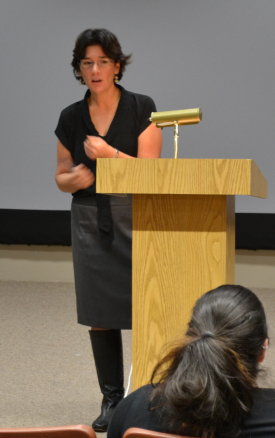By Dessa Bayrock (The Cascade) – Email
Print Edition: November 30, 2011
How do law and culture intersect to make indigenous women the target of discrimination? Last week, UFV guest lecturer Dr. Cheryl Suzack from the University of Toronto addressed questions like these during her talk “Trapped in one of the oldest ways: Indigenous women, literature and the law.” The event, held on November 22, was hosted by the Faculty and Student’s Association. Suzack’s specialty is a cross between literature, law and aboriginal culture.
About 25 students, faculty and staff turned out to see Suzack speak. She began her lecture by thanking the local Stó:l? people, as well as the Status of Women Committee who invited her to speak at UFV.
“It’s so inspiring to see students who are actually curious!” Suzack began, before commencing her lecture.
Suzack recently co-edited UBC Press’ collection Indigenous Women and Feminism: Politics, Activism, Culture and is in the process of putting together a similar work entitled “Indigenous Women’s Writing and the Cultural Study of Law.” Suzack’s lecture followed along the same lines: she explained to her audience how aboriginal women in North America have been treated in terms of “issues of race and gender discrimination” when it comes to both federal and tribal law.
The contrast between law and aboriginal culture is not a new one; the interesting angle Suzack took was to compare her findings to literature discussing the same topics. Although her work still “has the touch of academic research to it,” Suzack said that she still feels that joy and curiosity are the underlying currents in all her work; she also feels that this is an area that should be studied and spoken about. The aboriginal community, she said, is very tightly knit – to the point where these issues are simply not spoken about, despite being universally understood. “Women… are confined by their cultural responsibilities,” said Suzack, and when it comes to tribal law, they can be recognized as members of a culture while still suffering from a constant gender bias.
Suzack used an example from the United States to illustrate this point: Julia Martinez of the Pueblo people in Santa Clara was one of the first aboriginal women to stand up and struggle against clear gender bias in tribal law by fighting to have her half-blooded children accepted as members of her tribe. Traditionally, children with native fathers are accepted by the tribe as full members; children borne by native mothers and non-aboriginal fathers, however, are not. It’s partly and most obviously in this manner, Suzack said, that tribal law has “played a key role in diminishing native women’s role in their communities.”
Suzack said that it has been her goal, through her published work and lectures, to encourage the identities of aboriginal women by bringing together literature and law. “I’m delighted by the language of the human being,” she said, “and I want to embrace a community where every person can be accepted, heard, and respected, regardless of race, gender, or law.”


